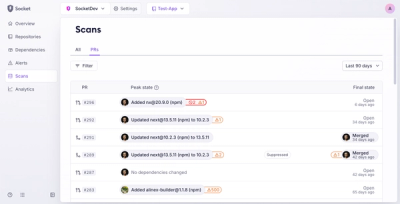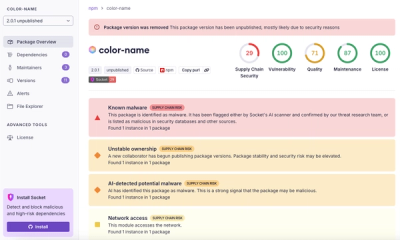
Security News
MCP Steering Committee Launches Official MCP Registry in Preview
The MCP Steering Committee has launched the official MCP Registry in preview, a central hub for discovering and publishing MCP servers.
angular2-config-generator
Advanced tools
An opinionated configuration generator for your Angular 2 environment. (Webpack 2, Karma and Jasmine)
An opinionated configuration generator for your Angular 2 environment. Generates customizable Webpack 2, Karma and Tslint configurations.
npm install angular2-config-generator --save-dev
Create webpack.config.js.
'use strict';
module.exports = require('angular2-config-generator').webpack();
Create karma.conf.js.
'use strict';
module.exports = require('angular2-config-generator').karma(
require('./webpack.config')
);
Setup package.json scripts.
"scripts": {
"start": "ng-start",
"test": "ng-test"
}
After this the application can be run with npm start
and will be available on http://localhost:3000.
An example application is inside the src directory
and can be copied as is to try out the package.
The setup consists of 3 entry points. All bundling is done with Webpack 2. They have to be at the exact same location if you don't modify the config files.
src/app/main.ts for main application logic and bootstrappingsrc/app/vendor.ts for vendor packages and common filessrc/app/test.ts for running test filesAll files under the src directory will be publicly available.
After every modification to the source files, the page will be reloaded with the newly generated files.
The concept is to have one configuration file for Webpack and one for Karma.
Behind the scenes it decides based on environment variable(process.env.NODE_ENV),
NPM lifecycle event(process.env.npm_lifecycle_event) or
given option(options.environment) which mode to run.
lifecycle == 'start' is development live-reload modelifecycle == 'test' is testing single-run modelifecycle == '*test*' is testing continuous-run modelifecycle == 'build' is production single-run modeenv|options.enviroment == 'development' is development live-reload modeenv|options.enviroment == 'test' && options.singleRun is testing single-run modeenv|options.enviroment == 'test' is testing continuous-run modeenv|options.enviroment == 'production' is production single-run modeTypescript files are translated with awesome-typescript-loader.
Inside components styleUrls and templateUrl will be inlined with angular2-template-loader.
When using loadChildren inside routing,
it will be moved to separate chunks with angular2-router-loader.
Inside the src/app directory .css files will be required as strings to work with angular2-template-loader.
Outside this directory they will be moved to a single file(style.bundle.css) with extract-text-plugin.
Currently only CSS files are supported for stylesheets.
But if you want another format, just add it to modules.rules after the package generated the Webpack config.
Additional loaders are added for images and fonts to handle them inside stylesheets.
For test running Jasmine is used in combination with Karma + PhantomJS browser.
Tests can be run with the npm test command.
It runs all files with *.spec.ts extension inside the src/app folder.
The test setup is done in src/app/test.ts.
To run tests continuously add the following script: "scripts": { "test-watch": "ng-test --watch" }.
It will speed up rebuilds and run the tests automatically after every change.
Linting is done with Tslint and Codelyzer rules. It is included as a pre-loader for Webpack.
Also an opinionated ruleset is exported based on tslint:recommended.
It's setup:
{
"extends": "angular2-config-generator"
}
After adding "scripts": { "build": "ng-build" } and running it,
the generated files will appear in the dist folder. These are minified and ready for deployment.
Github Pages deployment can be done with "scripts": { "deploy": "ng-deploy" }.
It can be enabled with the --aot flag for both starting and building the application.
"scripts": {
"start": "ng-start --aot"
"deploy": "ng-deploy --aot"
}
Instead of the original endpoint src/app/main.ts it starts from src/app/main.aot.ts.
FAQs
An opinionated configuration generator for your Angular 2 environment. (Webpack 2, Karma and Jasmine)
We found that angular2-config-generator demonstrated a not healthy version release cadence and project activity because the last version was released a year ago. It has 1 open source maintainer collaborating on the project.
Did you know?

Socket for GitHub automatically highlights issues in each pull request and monitors the health of all your open source dependencies. Discover the contents of your packages and block harmful activity before you install or update your dependencies.

Security News
The MCP Steering Committee has launched the official MCP Registry in preview, a central hub for discovering and publishing MCP servers.

Product
Socket’s new Pull Request Stories give security teams clear visibility into dependency risks and outcomes across scanned pull requests.

Research
/Security News
npm author Qix’s account was compromised, with malicious versions of popular packages like chalk-template, color-convert, and strip-ansi published.